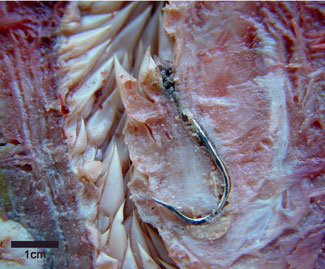Fishing lines kill sea turtles

The loggerhead sea turtle (Caretta caretta) is a widespread species of sea turtle greatly threatened by the increase in accidental catches by longline sets. In some areas, such as the Mediterranean sea, fishhook ingestion causes traumatic injuries in the gastrointestinal tract, leading to death in some cases. However, it has been stated that sea turtles are apparently able to sustain considerable injuries and still survive with hooks in the gastrointestinal tract. Most turtles accidentally captured by fishing activities are released with the hook still inside, and scant information about the effect of hook retention in turtle survival is available. An experiment in 11 juvenile turtles with a hook lodged in the esophagus or stomach revealed that about 50% of them were able to eliminate the hook without distress.
This study describes four cases of loggerhead sea turtles with fishhooks in the gastrointestinal tract. Two dead turtles with a hook in the esophagus had local fibrosis with an invagination of the keratinized stratified squamous epithelium surrounding the hook, isolating it from the subjacent stroma, one had a hook in the cloaca which was expelled spontaneously, and one had plication of the intestine with necrosis caused by the long monofilament line attached to the hook lodged in the esophagus. Lethal injuries were related to the effect of strangulation and traction produced by the line throughout the gastrointestinal tract rather than the presence of the hook in the esophageal mucosa. Hook size, point of attachment to the gastrointestinal tract, the presence or not of a long monofilament line, and the traction applied by it could be crucial for turtle survival.
Servei Ecopatologia Fauna Salvatge
Universitat Autònoma de Barcelona
References
"Fishhook lesions in Loggerhead Sea Turtles" Valente, ALS; Parga, ML; Velarde, R; Marco, I; Lavin, S; Alegre, F;Cuenca, R. JOURNAL OF WILDLIFE DISEASES, 43 (4): 737-741 OCT 2007


